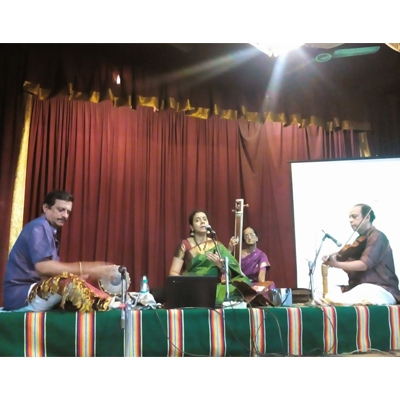
Different aspects of Siva bhakti
The final session of the lec-dem mela organised by Sruti and Karnatic Music Forum was a well-researched presentation by Carnatic musician Gayathri Girish. She presented ‘Different Aspects of Siva Bhakti’. With Mullaivasal Chandramouli on the violin and Chidambaram Balashankar on the mridangam giving her able accompaniment, she took up songs composed by many saints to illustrate her given topic.
Gayathri began with Tyagaraja’s Deva deva Sadasiva in raga Sindhuramakriya, where he implores the lord to bless him with devotion to his lotus feet. Bhakti can be in five stages – the lowest stage – manda bhakti – is when a person turns to God only in his hour of need; the madhyama bhakti is torn between belief and doubt; the highest, uttama bhakti is total surrender to God. Viswaroopa bhakti is seeing God in everything; and the last is the state of self-realisation.
Srimad Bhagavatam tells us of the Navavidha bhakti – the nine types of devotion. The Bhagavad Gitatalks of four kinds of bhaktas. Gayathri classified ten types of bhakti and demonstrated them with songs by different composers.
Adi Sankara’s sloka Karacharanamva pleads for forgiveness for misdeeds – this shows the devotee’s misery. There are many songs where the composer despairs the life he has taken and pleads for release from the cycle of birth and death.
Many are the songs that the seers sang in ecstasy, glorifying their god. Gayathri sang a number of songs by Appar, Sundarar and explained their literary beauty as well.
Tanjavur Ponniah Pillai’s varnam Paavaai nee paaraai shows sringara bhava. Sakhyam is seen in Marimutha Pillai’s Enneramum kaalaithookki in Todi raga. The composer converses with Siva and questions the reason for lifting his foot – is it because he is tired after destroying Daksha’s yagna? Or is it that his foot is tired after kicking Yama? Or could it be that his foot is tired after the frenzied dance with Kali? Did the poison flow down to his foot from his throat? Is he dancing for the benefit of Patanjali and Vyaghrapada? The string of questions that the devotee nonchalantly throws shows his relationship with his god as an equal.
Papanasam Sivan’s Piravaavaram taarum asks for ending of the birth cycle, and for constant remembrance (maravaavaram).
Neelakantha Sivan shows yearning and impatience in Endraikku Sivakripaivarumo. Simple and innocent bhakti is shown by simple village folk. This can be seen in Manikkavachagar’s songKaasanimingal that is also set to a lilting folk tune.
Total surrender is seen in Ramalinga Adigalar’s Tiruvarutpa. Gayathri said that every bhakta goes through the transition of various stages in his spiritual growth. She sang Tandaiyumtaayumguruvumin Surati to demonstrate this bhava.
Kavi Kalamegam makes clever play of words in his verse Mukkaalukkegaamun. The obvious meaning is that one should cultivate bhakti early in one’s life before his faculties deteriorate. But what is amazing is his use of the measures used in those times to denote the periods in one’s life.
Gayathri aptly concluded with Papanasam Sivan’s song Nambikkettavarevaraiyya, which includes many of the categories that she had listed out, and firmly reiterates that Siva bhakti will certainly, without doubt, lead a man to higher goals.
Sruti Editor-in-chief V. Ramnarayan proposed the vote of thanks. It was certainly a successful lec-dem mela with good public response to all the sessions.


